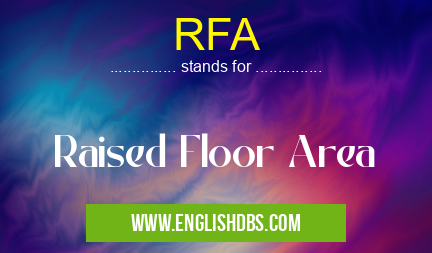What does RFA mean in UNCLASSIFIED
RFA is an acronym that stands for Raised Floor Area. It refers to a specialized type of flooring system that elevates the floor surface above the structural slab or subfloor. Raised floor systems are commonly used in various commercial, industrial, and technical applications.

RFA meaning in Unclassified in Miscellaneous
RFA mostly used in an acronym Unclassified in Category Miscellaneous that means Raised Floor Area
Shorthand: RFA,
Full Form: Raised Floor Area
For more information of "Raised Floor Area", see the section below.
Purpose and Applications
- Allows for concealed routing of cables, wires, mechanical ducts, and other infrastructure beneath the raised floor panels.
- Improves accessibility for maintenance, repairs, and upgrades of electrical, mechanical, and communication systems.
- Provides environmental control by allowing for the distribution of air conditioning, heating, or ventilation systems beneath the raised floor.
- Reduces noise levels by absorbing vibrations and dampening sound transmission.
Types of RFA Systems
RFA systems come in various types and materials, including:
- Steel: Durable and high-load capacity, suitable for heavy equipment and industrial applications.
- Aluminum: Lightweight and corrosion-resistant, ideal for cleanrooms and data centers.
- Concrete: Fire-resistant and sound-absorbing, used in areas with high fire safety or noise concerns.
- Composite: A combination of materials, offering a balance of strength, weight, and cost.
Design Considerations
When designing an RFA system, factors such as load capacity, height requirements, access needs, and environmental conditions must be considered. Proper planning and installation are crucial for ensuring optimal performance and longevity of the system.
Benefits of RFA Systems
- Enhanced flexibility and adaptability for future changes in infrastructure.
- Reduced downtime and maintenance costs due to improved accessibility.
- Improved indoor environmental quality through controlled airflow and ventilation.
- Increased energy efficiency by reducing heat loss and optimizing airflow.
Essential Questions and Answers on Raised Floor Area in "MISCELLANEOUS»UNFILED"
What is Raised Floor Area (RFA)?
Raised Floor Area (RFA) refers to the total horizontal surface area of a raised floor system within a data center or other technical facility. It is measured in square meters or square feet and determines the usable space for equipment, cabling, and other infrastructure components.
Why is RFA important in data centers?
RFA is crucial in data centers as it provides flexibility and accessibility for managing critical infrastructure. Raised floors create a hollow space beneath the elevated floor panels, allowing for efficient airflow, cable routing, and maintenance access without disrupting operations.
How is RFA calculated?
RFA is typically calculated by measuring the total floor area of the raised floor system, excluding any fixed structures or obstructions within the space. It is expressed in square meters or square feet.
What factors influence RFA in data centers?
Several factors influence RFA requirements in data centers, including:
- Equipment density and power consumption
- Airflow and cooling requirements
- Cable management and routing needs
- Maintenance and accessibility considerations
- Building codes and space constraints
How can I optimize RFA utilization in my data center?
To optimize RFA utilization:
- Plan for efficient equipment layout to minimize wasted space
- Utilize vertical space by installing equipment in racks or cabinets
- Implement cable management systems to reduce clutter and improve airflow
- Regularly audit the data center to identify underutilized or inefficient areas
Final Words: Raised Floor Area (RFA) systems offer a versatile and effective solution for concealing infrastructure, improving accessibility, and enhancing environmental control in various applications. By understanding the purpose, types, and benefits of RFA systems, architects, engineers, and facility managers can leverage their advantages to create efficient and adaptable spaces.
RFA also stands for: |
|
| All stands for RFA |
